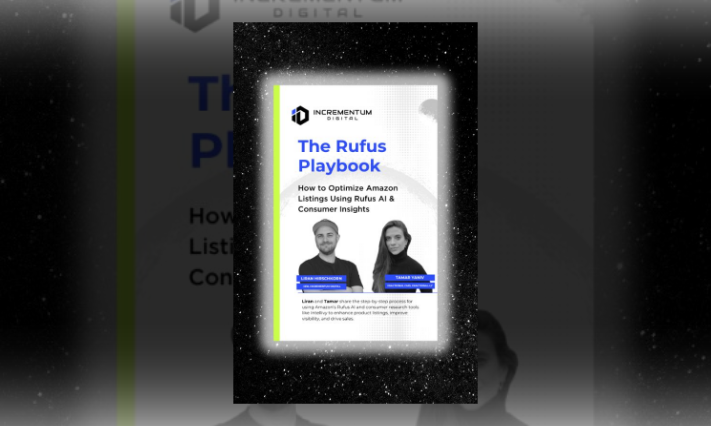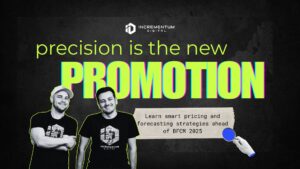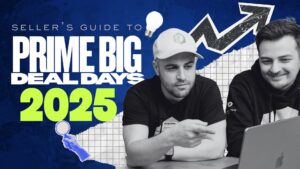Amazon Advertising
How to Prepare for Amazon Prime Day 2025: The Sellers’ Essential Guide
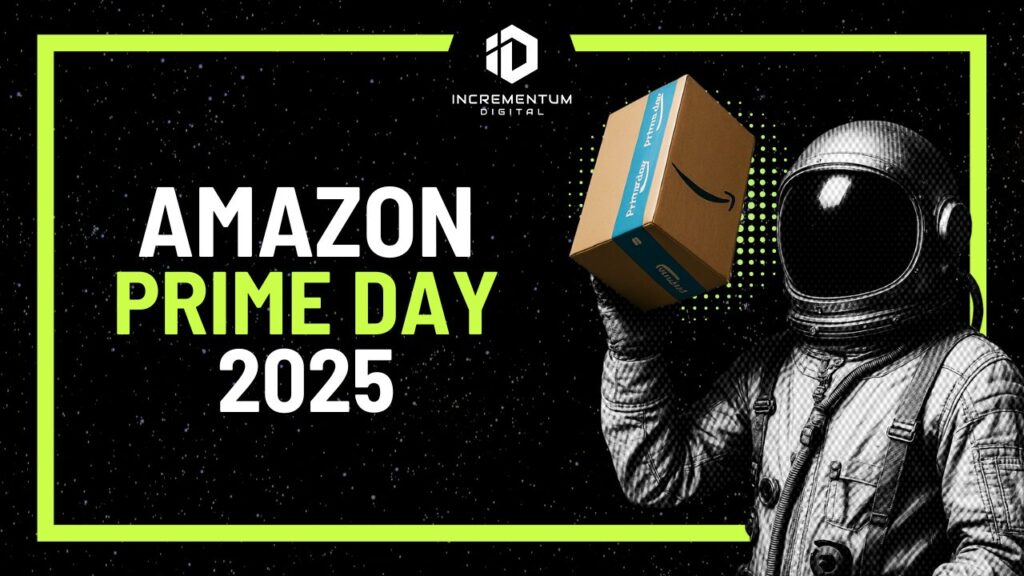
If Prime Day has crept up on you in the past, you’re not alone. A lot of brands start planning when it’s already too late. And this year, that window is even tighter. Amazon has changed the rules. Search is now powered by AI. Fees are up. Ad space is more competitive. And customers? They’re expecting more value, better experiences, and fewer gimmicks. Those who still treat Prime Day like a flash sale are going to miss the real opportunity. This guide breaks down how to prepare early and strategically, based on how Amazon actually works now, not how it worked last year. Also, if you scroll to the end, you can grab our fully built Prime Day Prep Calendar and stay ahead of every key deadline.
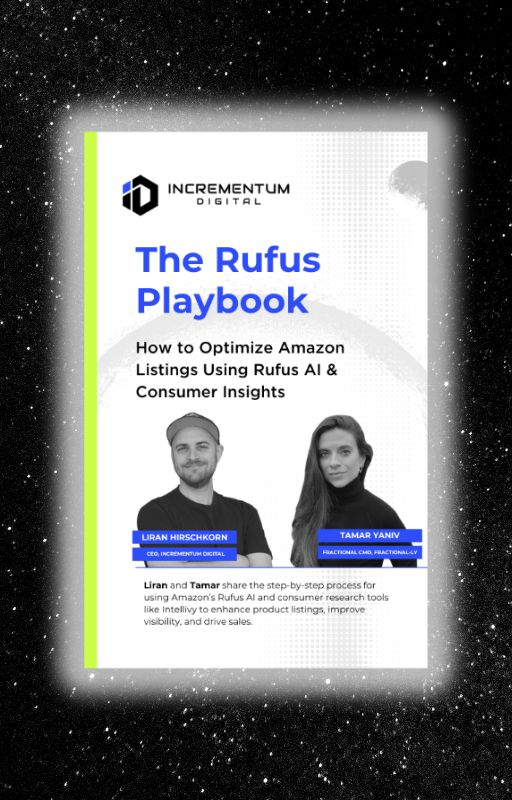
Learn How to Make Listings That Convert in 2025!
Read our step-by-step guide on how to optimize your listings using Rufus AI insights. Sign up for our newsletter and get your copy for free!
Show me howTip #1: Understand the New Playing Field
2025 is a different battlefield. Here’s what changed.
Selling on Amazon still comes down to visibility, conversion, and execution, but the levers that drive each one have shifted. In 2025, success depends on how well your brand adapts to Amazon’s evolving systems, higher operational pressure, and increasingly selective customers. These aren’t small tweaks; they’re structural shifts in how products are discovered, evaluated, and purchased. Here’s what’s different this year and how that impacts the way you need to prepare:
1. Rufus AI is reshaping product visibility
Amazon’s new AI search assistant, Rufus, doesn’t just match keywords; it interprets meaning and serves contextually relevant products based on a shopper’s intent, not just their phrasing.
This changes how you structure your product listings and Storefront:
-
- Descriptions need to answer buyer questions, not just hit SEO checkboxes
- Content hierarchy matters: the top 200 characters of your bullet points now carry more weight
- Product FAQs, reviews, and A+ content help train Rufus to understand why your product is the best fit
If your listings are still focused on keyword match types instead of addressing how real shoppers search and ask questions, it’s time to shift. Rufus is changing the rules of product discovery, and we’ve broken down exactly how to adapt.
Download the Rufus Playbook for a practical guide to optimizing your listings for Amazon’s AI-powered search.
2. Amazon’s fee structure is punishing inefficiency
New FBA fees in 2025 target two things:
-
- Low-inventory velocity (slow movers cost you more)
- Bulky or oversized units (especially across multiple FCs)
Accurate forecasting and leaner shipping strategies are not optional in 2025. With higher storage and fulfillment fees, especially for bulkier or slower-moving products, inefficiencies cut straight into your margin. We’ve broken down what’s changed and how to adjust: Read our post on Amazon’s 2025 fee updates.
3. Visibility now costs more (and pays off less if you’re sloppy)
Prime Day ad costs are climbing, which makes every click more valuable. Strong conversion rates are what turn that spend into real return. If your product pages aren’t optimized to convert, even well-targeted traffic can underdeliver.
Brands that thrive this Prime Day will:
-
- Start campaigns early to drive awareness while CPCs are lower
- Use DSP and retargeting to own the mid-funnel
- Monitor in-session behavior to optimize creatives and A/B test before July
4. Bundling, Brand Stores, and creator content are no longer optional
Shoppers are more selective, more skeptical, and more value-focused. Amazon knows this and is prioritizing listings that show clarity and confidence through:
-
- Smart bundles (especially those that increase AOV and reduce pick/pack costs)
- Optimized Brand Stores as ad landing hubs
- Creator-connected content through Amazon Live and Posts
Running a single discounted ASIN isn’t enough to stand out anymore. Leading brands are using immersive storefronts, bundled offers, and dynamic content to create a full experience that drives higher engagement and conversion. Want to level up your approach? Explore Amazon’s free tools to help you build stronger, more competitive campaigns.
Tip #2: Rework Your Product Discovery Strategy
Search is now smarter, and so must your listings be.
With Amazon’s push to make Rufus AI play a central role in how shoppers find products, product discovery on Amazon has shifted from keyword targeting to intent matching. This means your listings are no longer evaluated solely by how many keywords they contain but by how well they answer real shopper questions.
Rufus processes natural language queries like “What’s the best protein powder for post-workout recovery?” and surfaces products based on contextual relevance, not just keyword density. If your title or description simply says “Whey Protein Powder – Chocolate – 2lb,” you’re missing the opportunity to connect to buyer intent. To align with this shift:
1. Write for intent, not just search terms
Use your titles and bullet points to clearly communicate who the product is for, when it should be used, and what sets it apart. A well-structured title that says “Whey Protein for Muscle Recovery, 2lb – Fast Absorbing, Low Sugar” signals more value than generic descriptors. Descriptions should read like answers to customer questions. Think benefits, not features. Spell out the use case, anticipated outcome, and differentiator.
2. Use comprehensive content to reinforce trust and context
Rufus also pulls from product images, Q&A, and reviews to build its understanding of a product’s relevance. That means every touchpoint counts. Use lifestyle images to show the product in action. Ensure Q&A sections are populated with answers that reinforce core value propositions. Encourage reviews that speak to specific use cases and benefits.
3. Treat A+ Content and Brand Stores as part of the discovery engine
A+ Content is not just for post-click conversion anymore. Rufus uses it to validate product context and enhance its recommendations. Make sure your A+ modules reinforce your core messaging, with clean formatting and scan-friendly content.
Brand Stores should guide shoppers through your product lineup with a clear structure and strong visuals. They are increasingly used as landing destinations for Sponsored Brand and DSP traffic. If your store is just a collection of ASINs without a narrative or hierarchy, you are leaking opportunity.
Optimizing for 2025 search means thinking like a strategist. Every word, image, and customer interaction teaches Amazon’s AI who your product is for. The better you align your content to shopper intent, the more visible you become.
Tip #3: Plan Early, Launch Sooner
The top performers don’t wait until July.
Brands that win Prime Day are not scrambling to launch their campaigns on July 15. They are already scaling. The most effective strategies start weeks before the first Prime Day click.
1. Activate warmup campaigns at least 4 weeks early
If you want to win in Prime Day’s peak hours, you need to build momentum before then. Launching DSP and Sponsored Ads in late June allows you to:
-
- Build retargeting audiences
- Test audience segmentation
- Establish campaign history that improves delivery efficiency
Warm audiences convert better. Trying to acquire cold traffic on Day 1 leads to higher costs and weaker ROAS.
2. Test creative and bidding strategies while CPCs are lower
Early campaigns give you time to identify which ad creatives perform best. You can rotate headlines, images, and video to see what actually drives clicks and conversions before costs spike in mid-July. You also gain visibility into how your bids behave under different scenarios.
3. Lock in inventory and shipping plans now
You cannot afford stockouts or late arrivals in July. Review your inventory velocity, confirm purchase orders, and finalize prep windows with your 3PL or FBA workflows. If your inventory arrives late or incomplete, your ads will burn budget without delivering revenue. Worse, you may lose Buy Box or Prime eligibility when it matters most.
4. Factor in tariff risks with contingency pricing
With potential policy changes and renewed tariff proposals, brands importing from overseas need to build flexibility into their pricing and margin plans. Do not assume your landed costs will remain stable into Q3. Create a pricing matrix that covers different landed cost scenarios. Identify bundles or value-adds you can adjust to protect margin without pulling back on promotional strength.
Tip #4: Build Value, Don’t Just Discount
Winning isn’t about offering the biggest discount.
Price-slashing alone doesn’t win Prime Day anymore. Shoppers are more discerning, more price-savvy, and more flooded with options than ever. Offering 40 percent off isn’t impressive if your competitors are doing the same, or if your offer looks generic. What separates the top-performing brands is perceived value, not raw discount percentage.
1. Bundle to increase average order value without eroding margin
Smart bundles are one of the most effective ways to stand out. When done right, they raise perceived value while giving you better control over profit margins and fulfillment efficiency.
Focus on:
-
- Solution-based bundles, where products complement each other
- Limited-time kits that are exclusive to Prime Day
- Multipacks for consumables that drive up volume and convenience
The key is to frame the bundle as a better deal and a better solution.
2. Use strategic offers like Prime Exclusive Discounts and gifts-with-purchase
Prime Exclusive Discounts are prioritized in search results and provide a strong conversion bump. They also allow you to target high-intent shoppers without broadcasting discounts to non-Prime users.
Gifts-with-purchase, especially for mid-ticket or luxury items, can create outsized perceived value with minimal cost. A well-placed add-on can turn a browser into a buyer.
3. Make your value clear through visuals and structure
Having a good offer is not enough; it has to be seen and understood in seconds. Your main image should clearly show what’s included in the bundle. Your bullet points and A+ content should emphasize savings and convenience.
Use banners and product tiles on your Brand Store to highlight bundles, limited-time deals, and promotions. If your Store looks identical to the rest of the year, you’re missing the opportunity to guide shoppers toward high-value conversions.
Discounting without structure is a race to the bottom. Value-building creates differentiation, protects margin, and leads to higher lifetime value customers, not just one-time clicks.
Tip #5: Be Ready to Optimize in Real Time
Prime Day is a high-speed sprint that rewards agility.
While Prime Day has traditionally been a 48-hour window, reports indicate Amazon may expand the event to four days in 2025. That change creates more opportunity but also more complexity. Success will depend on your team’s ability to monitor, adapt, and act without hesitation.
1. Watch performance metrics by the hour
Prime Day traffic surges are not consistent. Peaks vary by category, region, and even time of day. You cannot set your bids and budgets in the morning and check back at close. Monitor:
-
- Bid competitiveness
- Budget pacing
- Click-through and conversion rates
- Placement performance
Set alerts for key thresholds and allocate time blocks to review campaign performance frequently.
2. Prepare backup creative and targeting in advance
If your top-performing ad starts to fatigue or your audience pool underperforms, you need options ready to go. Have alternate headlines, image variants, and keyword sets pre-approved and loaded. Do not wait for performance to dip before making a change.
This is especially critical if the event does run four days. Creative fatigue is real, and shopper behavior evolves as urgency builds.
3. Use dashboards and decision rules to stay proactive
Build live dashboards in your ad platform or analytics tools to surface only what matters. Focus on metrics that show campaign health and momentum, not vanity data. Align your team on predefined triggers that warrant action so you can move quickly without second-guessing.
Speed beats perfection during Prime Day. The brands that monitor, iterate, and optimize in near real-time are the ones that sustain performance beyond day one. Whether the event runs two days or four, your ability to respond faster than the competition is a direct lever on ROI.
Tip #6: Post-Prime Day Debrief
What you learn in July can make or break Q4.
Prime Day is one of the clearest stress tests for your brand’s performance. It reveals what’s working, what’s not, and where there’s opportunity to improve. The brands that review this data critically will move faster and make sharper decisions for the next sales cycle.
1. Evaluate SKU-level performance
Review conversion rates, ad spend efficiency, and sales velocity for each ASIN. Look for products that underdelivered despite visibility, and flag top performers for additional support in Q4.
2. Identify high-performing audiences and placements
Dig into your ad reports to find which targeting groups, creative formats, and placements delivered the strongest results. Use that data to refine your paid strategy for Q4 and retarget based on actual buyer behavior.
3. Make adjustments that directly support your next move
Update your pricing, refine your creative, and revisit packaging or bundling based on performance trends. Address any operational bottlenecks that surfaced during the event so they don’t repeat during the peak holiday season.
Ready for What’s Next?
Prime Day is only the beginning. What you do with the data, momentum, and insights will define how you perform in Q4 and beyond. If you want to move faster, optimize smarter, and close the gaps in your current Amazon strategy, we can help.
Our team has managed over $100 million in Amazon ad spend across CPG, wellness, beauty, and more. We know what works, what doesn’t, and what’s changing—and we’ll show you exactly where your brand stands.
Book a free Amazon Brand Audit today.
Get our Prime Day 2025 Prep Calendar here
Stay ahead of every key deadline with the same timeline we use to manage $100M+ in Amazon ad spend across CPG, wellness, and DTC brands. This shareable calendar covers strategy, deals, inventory, ad setup, creative testing, and post-event analysis, everything your team needs to execute without scrambling.
Pro tip: Subscribe via Google Calendar to get real-time updates as deadlines or details evolve.
LET’S DISCOVER WHAT’S POSSIBLE FOR YOUR BRAND
We’re here to listen and uncover opportunities tailored to your unique goals.
Fill out the form to get started, and you’ll walk away with real insights and actionable recommendations—whether we work together or not.
- HANDS-ON LEADERSHIP
- AWARD-WINNING PARTNERSHIPS
- CUSTOM-BUILT SOLUTIONS
